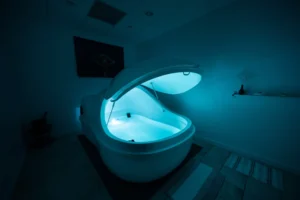In today’s fast-paced, stressful world, emotional well-being is often overlooked. People are constantly searching for ways to restore inner balance and peace and one emerging solution is Float Therapy. Also known as Sensory Deprivation Float Therapy, this practice is gaining attention for its powerful impact on mental and emotional health. But Float Therapy is exactly what it is exactly, and how can it help with depression, anxiety, and relaxation? Let’s dive into the science, effects of float therapy, and the benefits of floatation tanks for emotional healing.
Float Therapy: What Is It?
So, Float Therapy what is it? At its core, Float Therapy (or Float Session Therapy) involves lying in a specially designed isolation tank therapy or sensory deprivation float tank filled with warm water and Epsom salt. The salt makes you effortlessly buoyant, while the tank minimizes external sensory input light, sound, and even gravity seem to disappear.
This float therapy session allows your mind and body to enter a deeply relaxed, meditative state. The purpose of sensory deprivation tank design is to reduce external stimuli and promote complete mental stillness. Within minutes, your brain shifts from its usual alert beta state to slower alpha and theta waves the same frequencies reached during deep meditation or REM sleep.
The Science Behind Float Therapy
Understanding the science behind float therapy helps explain its emotional and physical benefits. During a float session therapy, the body experiences a reduction in cortisol (the stress hormone) and an increase in dopamine and endorphins, chemicals responsible for happiness and well-being.
Several studies have explored the health benefits of float therapy, showing improved mood, reduced anxiety, and enhanced emotional regulation. When external stimuli are removed, the mind can finally process unresolved emotions and release built-up stress. This “reset” effect is one of the key float tank therapy benefits and contributes significantly to emotional healing.
Benefits of Float Therapy for Emotional Healing
1. Deep Relaxation and Stress Reduction
One of the most recognized float session benefits is profound relaxation. Floating triggers a parasympathetic nervous system response, slowing the heart rate and calming the mind. The benefits of float therapy extend beyond simple stress relief; it allows emotional decompression on a deep level.
The benefits of sensory deprivation float tanks are especially powerful for those living with chronic stress. After a float therapy session, people often report feeling refreshed, balanced, and mentally clear. This reduction in stress hormones supports emotional stability and inner peace.
2. Float Therapy for Depression
The emotional benefits of float therapy for depression are backed by research. Depression often involves overactivity in brain areas related to worry and rumination. A float deprivation tank calms these regions, helping individuals break free from negative thought cycles.
Because isolation tank therapy promotes serotonin and dopamine release, it naturally uplifts mood. Over time, the effects of float therapy can mirror those of meditation and mindfulness practices, making it a complementary approach to managing depressive symptoms.
3. Float Tank Anxiety Relief
Another important use is float tank anxiety reduction. During float session therapy, the absence of external input allows the nervous system to reset. Studies show that float tank therapy benefits include lowered anxiety levels, even for individuals with generalized anxiety disorder.
For people struggling with performance anxiety, PTSD, or social anxiety, float therapy for relaxation offers a safe, controlled environment for emotional recovery. Floating promotes mindfulness and presence skills crucial for managing anxiety long-term.
4. Enhanced Emotional Awareness
Many people experience emotional breakthroughs during a float therapy session. The purpose of sensory deprivation tank design is to silence distractions so you can tune into inner thoughts and emotions. This self-awareness fosters emotional healing and resilience.
As the health benefits of float therapy accumulate, users often find they can handle emotional triggers more effectively. The benefits of floatation tanks go far beyond relaxation; they cultivate inner clarity and self-compassion.
5. Improved Sleep and Mental Clarity
Poor sleep can worsen emotional distress. Regular float session therapy helps regulate sleep patterns by lowering cortisol and balancing circadian rhythms. The float tank therapy benefits include deep, restorative sleep essential for mental health.
The effects of float therapy also include improved focus, creativity, and problem-solving. With the mind free from sensory overload, many report bursts of insight and enhanced mental clarity.
Health Benefits of Float Therapy for the Body and Mind
The health benefits of float therapy extend beyond emotional healing. Epsom salt (magnesium sulfate) used in float session therapy soothes muscles, reduces inflammation, and relieves chronic pain. Physically relaxed muscles send calming signals to the brain, further supporting emotional balance.
The combined float tank therapy benefits physical relief, mental stillness, and emotional clarity to create a holistic healing experience. Over time, the effects of float therapy build up, improving overall well-being.
Float Therapy for Relaxation and Mindfulness
Float therapy for relaxation is ideal for anyone seeking a mental escape from daily stress. The tranquil environment of a float therapy session mirrors deep meditation, offering an effortless entry into mindfulness.
Unlike traditional relaxation techniques, sensory deprivation float therapy minimizes the effort required to quiet the mind. Many users find that just one float session therapy feels like hours of restful sleep. Over time, this consistent relaxation contributes to emotional resilience.
Benefits of Floatation Tanks for Emotional Balance
The benefits of floatation tanks are multifaceted. Emotionally, they help users reconnect with themselves, process trauma, and release tension. The benefits of float therapy include improved mood regulation, better self-awareness, and enhanced compassion toward oneself.
Even those new to float therapy report feeling an immediate sense of tranquility after their first float therapy session. The benefits of sensory deprivation float tanks become more pronounced with regular use, helping maintain emotional stability.
Float Session Benefits for Long-Term Emotional Healing
Long-term float session benefits include reduced symptoms of anxiety, depression, and burnout. Many mental health practitioners now recommend float therapy for depression or float tank anxiety relief as a complementary treatment.
Regular float session therapy enhances the brain’s neuroplasticity and its ability to adapt and heal. This makes the effects of float therapy cumulative, with emotional healing deepening over time.
The science behind float therapy confirms that repeated sessions train the nervous system to relax more easily. This ability to return to calm after stress is the foundation of emotional healing.
Float Therapy What Is It in Modern Wellness
In modern wellness culture, float therapy has become a symbol of self-care and inner peace. Whether used for float therapy for relaxation, creativity, or recovery, the health benefits of float therapy are undeniable.
Many spas now offer packages for float session therapy, emphasizing the float tank therapy benefits for mind, body, and spirit. The purpose of sensory deprivation tank design remains the same to promote introspection and emotional balance in a fast-moving world.
Effects of Float Therapy on the Brain and Emotions
During a float therapy session, sensory inputs are minimized, allowing the brain to rest and recalibrate. This quiet environment activates theta brain waves, associated with creativity, introspection, and emotional processing.
The effects of float therapy can last for days after a single session. Users often describe feeling lighter, emotionally open, and mentally refreshed. These float deprivation tank benefits are key to lasting emotional healing and self-awareness.
Float Therapy for Depression and Anxiety: A Natural Remedy
As interest in holistic health grows, more people are turning to float therapy for depression and float tank anxiety relief. Unlike medication, isolation tank therapy has no side effects, making it a safe, natural option.
By consistently engaging in float therapy sessions, users train their brains to relax and self-regulate. The benefits of floatation tanks compound over time, offering a sustainable path to emotional wellness.
The Purpose of Sensory Deprivation Tank in Emotional Healing
The purpose of sensory deprivation tank therapy is simple to remove distractions so the mind can rest and heal. When external noise fades, inner awareness sharpens. This process allows repressed emotions to surface and be processed gently.
Whether you’re seeking float therapy for relaxation, emotional clarity, or spiritual growth, the benefits of float therapy support your journey toward self-discovery and peace.
FAQ: Float Therapy for Emotional Healing
1. What happens during a float therapy session?
During a float therapy session, you lie in a warm, saltwater tank designed to eliminate external stimuli. This sensory deprivation float therapy allows your mind to enter a meditative state, promoting relaxation and emotional balance.
2. How long does a float session therapy last?
Most float session therapy experiences last 60 to 90 minutes. Even one session provides immediate float session benefits, but regular floating enhances the effects of float therapy over time.
3. Are there real health benefits of float therapy?
Yes! The health benefits of float therapy include stress reduction, pain relief, better sleep, and improved mental clarity. These float tank therapy benefits contribute to overall emotional and physical well-being.
4. Can float therapy help with depression and anxiety?
Absolutely. Float therapy for depression and float tank anxiety management are among the most researched areas. Regular sessions can reduce symptoms naturally by balancing brain chemistry and calming the nervous system.
5. Is sensory deprivation float therapy safe?
Yes, sensory deprivation float therapy is completely safe for most people. The benefits of sensory deprivation float tanks are well-documented, and the environment is controlled, clean, and relaxing.
6. How many sessions are needed to see the benefits of float therapy?
Many users notice float session benefits after the first visit, but the effects of float therapy become more profound with consistent practice. Regular float therapy sessions can help maintain emotional stability and long-term wellness.
7. Can anyone try float therapy?
Most people can enjoy the benefits of floatation tanks, though those with certain medical conditions should consult a doctor first. The purpose of sensory deprivation tank design ensures comfort and accessibility for most users.
Conclusion
Emotional healing is not a one-time event but a journey and float therapy for relaxation offers one of the most effective, natural paths to achieving it. Through isolation tank therapy, you can disconnect from external chaos and reconnect with your inner peace.
The benefits of float therapy, supported by the science behind float therapy, make it a transformative experience for body, mind, and spirit. Whether you’re seeking relief from depression, anxiety, or daily stress, the benefits of floatation tanks can help you rediscover calm, clarity, and emotional balance.





